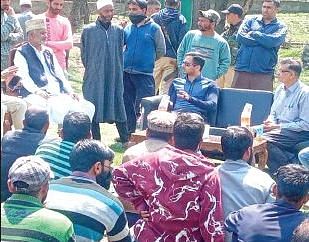By a far-less-than-exaggerated calculation, the villages of Jammu and Kashmir produce at least 500 tonnes of refuse daily. That is 1.75 lakh tonnes of waste a year – all garbage stinking to the high heavens.
How do we say so? Consider this: At least 1 crore people live in the Union Territory’s villages (90 lakhs by 2011 census figures).
According to government figures, the daily per capita waste production is about 220 grams.
Assuming that rural folks produce a mere 50 grams of waste per person per day, we have a mountain of garbage spread across J&K’s 6,900-plus villages.
The 1.75 lakh tonne figure, need one say, is vastly attenuated. In truth, it might even exceed twice this figure.
Much needs to be done about this pile of waste for J&K and it’s tourism economy to thrive.
More importantly, there is no study pointing to how much waste the countryside generates. There is no indication of how much of this waste is organic or inert or plastic or metallic.
There is no study to document the rapid change in the patterns of consumption or the generation of litter in villages. There are no clear statistics on the waste from the various agricultural practices.
There also seems to be an assumption that villagers do not discard glass, wrappings, plastics or e-waste or waste from demolishing old structures. They do.
A fieldwork for a study undertaken by Kashmir’s Yumberzal Applied Research Institute (KYARI) revealed that there is lack of strategy and planning to do something about this menace. Every inch of everybody’s imagination on the score is extended to the management of urban or municipal waste.
Take for instance the government document titled ‘Policy Regarding Jammu and Kashmir State Integrated Solid Waste Management Strategy 2017 Under Rule 11 (1) Solid Waste Management Rules, 2016’.
The 21 pages are limited to urban local bodies or municipalities. It does mention of waste from private gardens and even of dairy and cattle sheds within city limits, but the character of the document is deliberately urbane.
Ditto for the action plan document for municipal solid waste management framed by the housing and urban development department.
In short, both of these documents spread the government’s attention to 17 clusters, all of which are urban. However, one cannot fault these documents because both of these have been produced by the housing and urban development department who are mandated to plan for towns and cities.
Both these documents owe their legitimacy to the Solid Waste Management Rules, 2016. State and Union Territory governments were required to frame the action plans within a year.
The 2016 rules framed by New Delhi extend to every community across the country, whether urban or rural. The only exemption is industrial areas, to which a different set of rules apply.
What has this meant for villages? Let us consider the example of Aharbal, a verdant tourist spot in Kulgam, just about 75 km from Srinagar. Setting off Kulgam, all one sees along the way is heaps of polybags and single use plastics, like water bottles, strewn all over. It would seem that people are compelled to take such a route to a holiday or picnicking destination. At places, banks of river Veshaw are a dumping spot for plastics and waste sanitary wares.
The tourist destination itself is administered by the Aharbal Development Authority (ADA). The litter, locals insist, is left at the site by visitors and is not of their making. There is immense potential to attract more tourists, but for Aharbal to figure on the map of the Kashmir tourism industry, the place must look clean.
The trek route must be rid of the litter, dustbins need to be installed and emptied at regular intervals, and staff or safai-mitras must be engaged. In short, a detailed, monitor-able plan must be drawn out and put in place to clean and maintain the tourist destination.
A scientifically assessed system must be in place to disintegrate the plastic waste, as is happening in the tourist destination of Pahalgam not very far away.
There is every reason to believe that once this happens, and with refurbishing and regular upkeep of the infrastructure that the ADA has already put in place, Aharbal can be a destination of choice for tourists, and a money spinner for both the government and the locals. In the absence of a waste management plan, the beautiful tourist destination is rotting.
In short, a business can be modelled around handling waste in such a setting. And for this, the Panchayats must be enabled.
It is interesting to note that the Solid Waste Management Rules, 2016 cover the Panchayats as well. Action plans for rural communities can and must be drawn up to confirm to these rules, just as the housing and urban development department has done for the cities.
The rural communities need not be neglected, as they have been. Because waste is a problem for village folk and townspeople alike. Moreover, we now know that microplastics are entering our anatomies.
It is time J&K’s directorate of rural development and Panchayati Raj too initiates consultations on the subject of waste generated by households and economic activities in rural settings and brings out an action plan for Panchayats, similar to what their counterparts have done for municipalities.
Indeed, the Solid Waste Management Rules, 2016 have set the scope for the same.
The 15th finance commission has laid out a range of activities for Panchayats to undertake and there is scope for Panchayats to set up infrastructure and engage people to handle waste just like municipalities in towns and cities do.
The Solid Waste Management Rules, 2016 has even provided for local bodies to levy solid waste management charges from tourist to make the services sustainable.
Disclaimer: The views and opinions expressed in this article are the personal opinions of the author.
The facts, analysis, assumptions and perspective appearing in the article do not reflect the views of GK






